 Anyone who at least once grows the Bull's Eye variety will forever become a fan of this representative of cherry-shaped tomatoes. Fruits that look like the Bull's Eye cherry variety will delight you with a great taste and will decorate any area.
Anyone who at least once grows the Bull's Eye variety will forever become a fan of this representative of cherry-shaped tomatoes. Fruits that look like the Bull's Eye cherry variety will delight you with a great taste and will decorate any area.
Content
General description of the variety
To begin with, it is worth noting that most cherry tomatoes are hybrids, the Bull's Eye does not apply to those. This is a variety bred by specialists-breeders of the reliable Novosibirsk agricultural company “Siberian Garden”. It is entered in the state register of Russia in 2016, as a variety suitable for cultivation in the open ground and under film shelters in personal subsidiary plots.
Ripening dates and growing regions
Tomato has early ripening (90-95 days), and therefore is especially appreciated in regions with a protracted spring and late summer. But it is successfully cultivated throughout Russia. The variety is characterized by a long fruiting period, therefore it is more advisable to grow it in closed ground conditions. In glass and film greenhouses of medium latitudes, the Bullseye will produce crops until the frost, and in greenhouses with heating and lighting, vegetation can last more than one year. In regions with long and warm summers, tomato will have time to give a good share of the crop in the open ground.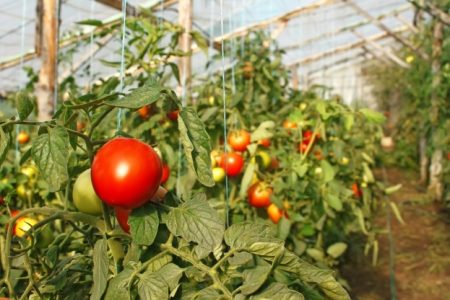
Plant characteristics and fruit characteristics
The variety is indeterminate, the height of plants in open ground reaches 2 meters, in the greenhouse growth is unlimited. A plant without a formation procedure branches very strongly. Stepsons are formed in the axils of the leaves, and peduncles on the shoots outside the sinuses. The stems of young bushes are soft, light green in color, and as they grow, they become lignified and if they are not tied, they lie down.
The brush that will give the first tomatoes is laid over the 7-8th sheet, the second - after 2 sheets. The first two brushes are simple with 10-12 fruits, the next are formed through 1-2 leaves and already carry 30-40 tomatoes. The flowers are large, in inflorescences they bloom after each other, which ensures almost simultaneous ripening of tomatoes in one brush.
Fruits of the same size, roundish shape and average weight not exceeding 30 grams. Fully ripened juicy red tomatoes with a smooth glossy surface. The flesh is bicameral, sweet and juicy. The peel is very tender and soft. Fruits are characterized by a high content of lycopene and sugars (more than 4.5%).
Productivity is high. In greenhouse conditions, it is 10-12 kg per square meter, in open ground 7-8 kg.
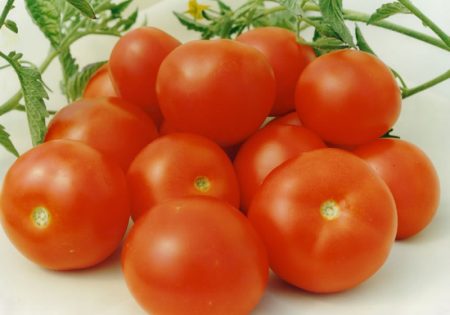
The purpose of the variety
Cherry tomatoes are used whole or halves to decorate meat dishes, salads, snacks. Due to the sweet dessert taste, the fruits are applicable not only in the usual vegetable, but also in fruit and berry salads.
"Bull's eye" in its characteristics is ideal for drying.Skillful housewives adapted to dry tomatoes at home with the help of electric dryers, ovens and air grills. In winter, this preparation will give any dish a unique taste and aroma.
Using these small and strong tomatoes, not only delicious, but also beautiful conservation is obtained. Particularly impressive look blanks with cherry tomatoes "on a branch."
In natural form, Bull's-eye tomatoes are eaten by both adults and children. With pleasure they are used even by those children who do not like vegetables.
It is profitable to grow this variety for commercial purposes. A long growing season and high productivity allow you to get a good profit. In addition, the price of this tomato variety is always an order of magnitude higher, and demand remains at a consistently high level year-round.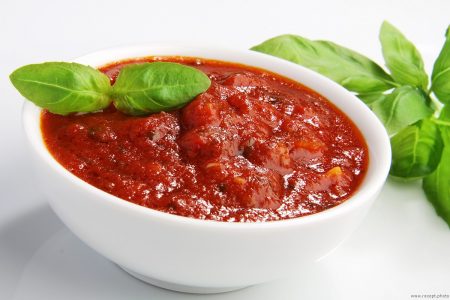
Planting and Care Recommendations
Seeding time
Sowing dates are individual and depend not only on the climate of the region, but on the method of cultivation: in a greenhouse or in open ground. In any case, breeders recommend sowing 45-50 days before transplanting. Tomatoes are planted in unheated greenhouses when the average daily temperature is set at not lower than 12 ° С. In open ground, landing is done when the threat of frost passes and the temperature at night does not drop below 10 ° C.
Soil preparation
The Bull's Eye variety, like most tomatoes, is demanding on the composition of the soil and its nutritional properties. It grows best on light and medium loamy soils with high fertility. Therefore, preparation for landing is carried out in advance, based on its condition. To improve the structure of heavy soil, sand, sawdust, humus are introduced into it. Too sandy and poor fertilize with a lot of good humus or compost.
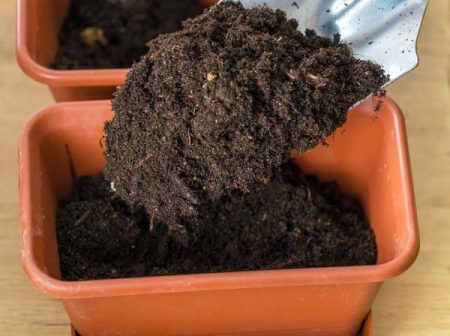 The order and scheme of landing
The order and scheme of landing
For full growth, development and fruiting, it is important to follow the planting scheme. So that the plants do not interfere with each other, no more than 3 bushes are planted per square meter.
Prepared wells are shed with a pink solution of potassium permanganate and sprinkled with ash. Saplings carefully get out of the pots, trying to save an earthen lump. Plants without deepening are placed in the center of the holes, sprinkled with earth and compacted soil. Then abundantly watered in several stages.
Important agricultural practices:
Shaping and tying a bush
The formation and tying of the Bull's Eye variety are mandatory and important procedures. If they are not completed, the bushes will quickly gain green mass and turn into impenetrable thickets crawling on the ground or going down to the ceiling of the greenhouse. Harvest in this case will be minimal.
Form bushes in one or two stems. The remaining shoots are regularly and carefully removed, leaving a stump of 1-2 cm. In addition, the leaves under the brushes, which began to sing, are periodically removed. Thin creeper stalk is tied up already 2 weeks after planting. In open ground and film greenhouses, a month before the onset of cool weather, pinch the top of the stem. This will make it possible to fully form and mature all the tomatoes.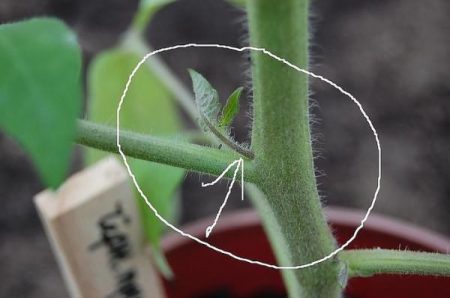
Watering, cultivating, mulching
The technique of watering cherry tomatoes is different from the usual. Plants of this subspecies do not tolerate drought and poorly tolerate excess moisture. Therefore, they should be watered every 2-3 days, but not too abundantly. Water should be well-maintained and warm. So that after watering there is no crust, the earth around the plants is mulched or loosened regularly.
The mulching layer may be made from natural or artificial materials.
It is good to use straw, young seedless weeds, sawdust, compost, newspapers as natural or organic mulch.Straw and newspapers are laid with a layer of 15-20 cm, young grass with a layer of 5 cm, compost of 3 cm. Gradually decomposing, these materials turn into humus and additionally fertilize the soil.
Artificial material, as a rule, is laid on the beds before planting tomatoes. Then, in accordance with the planting pattern, cross-shaped incisions are made into which plants are planted. In open ground, you can use black film or spanbond. In the greenhouse, the film is not recommended for use, this can lead to overheating of the soil.
Top dressing
Tomatoes are fed once every two weeks, starting 10-15 days after transplantation. For top dressing, you can use commercially available complex fertilizers in a large assortment or resort to folk recipes. A good option would be to alternate these methods. It is important to remember that nitrogen is required for the plant for active growth, potassium for the formation of stems and flowering, phosphorus for the development of the root system and ripening of fruits.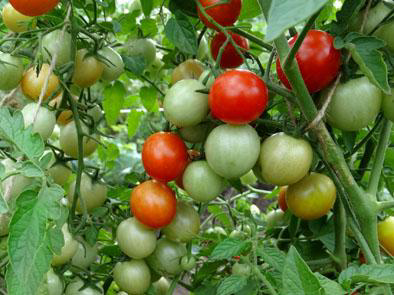
Disease and Pest Prevention
It is very difficult, and sometimes impossible, to treat tomato diseases. It is much easier to follow the following simple content rules:
- disinfect the soil before planting;
- water the plants only under the root, and not by sprinkling;
- avoid high humidity in shelters;
- Do not plant other crops in the greenhouse;
- avoid crowding of plants (observe the planting pattern, tear off stepsons, leaves);
- immediately remove plants with signs of fungal disease from the garden;
- regularly carry out preventive treatment against diseases and pests, alternating folk remedies with professional ones.
Harvesting
Harvesting tomato bull's eye can be done with brushes. Simultaneous ripening of fruits easily allows you to do this. It is important to remember that cherry tomatoes will be tasty and healthy only when fully ripened on the bush. Ripening at home reduces all useful and taste qualities to nothing.
Advantages and disadvantages of the Bull's Eye variety
The disadvantages, or rather, the features of the variety include:
All this is more than overlapped by a number of advantages:
- early ripening;
- long fruiting period;
- high productivity;
- beautiful appearance of the bushes;
- does not require complex agronomic techniques;
- universality of the use of fruits;
- excellent gastronomic qualities;
- high content of nutrients.
The Bullseye variety is an excellent representative of the subspecies of cherry tomatoes. Having planted several bushes of this variety and giving them a little attention and care, you will get a solid crop of tasty and healthy fruits.
Reviews
Natalia Vadimovna, 55 years old
I decided to try this new product from my beloved Siberian garden. Grew in a greenhouse, the bush is very powerful, grew more than 2 meters. The ripening period was more than early. The yield on the top five, was completely covered with long brushes with tomatoes. Taste excellent, very sweet. I especially liked that the peel is tender and does not feel at all when eating.
Ekaterina, 33 years old
Real indent, very tall and very branchy. Early ripe, unpretentious, disease resistant and productive variety. He knitted tomatoes until the last, until they cleaned the bushes. The fruits are bright red with a very sweet dessert flavor. We ate quickly, like sweets. Not a single tomato cracked. In our greenhouse, this variety received a permanent residence permit.
Eugene, 54 years old
The first year I planted the “Bullseye” in the open ground, the second in the greenhouse. Both times led into one stem, the result was equally excellent. The brushes form very long, 25-30 tomatoes each. In the open ground stood like a fountain, a very beautiful bush. True, the bushes still overtook late blight, but it was already very cold nights and constant dew. To taste, greenhouses are of course inferior to those that grew under the sun. The beds are sweeter and more fragrant. In general, the grade was very pleased, I will plant more.




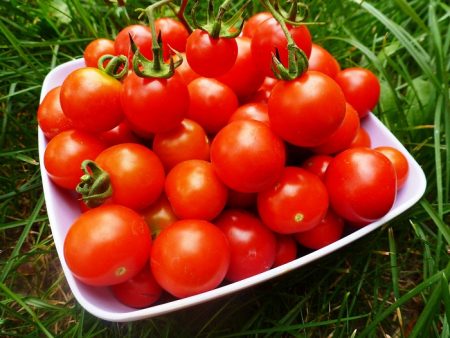
 Low-growing tomatoes, without pinching: 5 of the most delicious varieties
Low-growing tomatoes, without pinching: 5 of the most delicious varieties Why tomato seedlings grow poorly
Why tomato seedlings grow poorly We grow a tomato in a shell
We grow a tomato in a shell Growing tomatoes without watering according to the method of Kazarin
Growing tomatoes without watering according to the method of Kazarin
Marina
Very barren